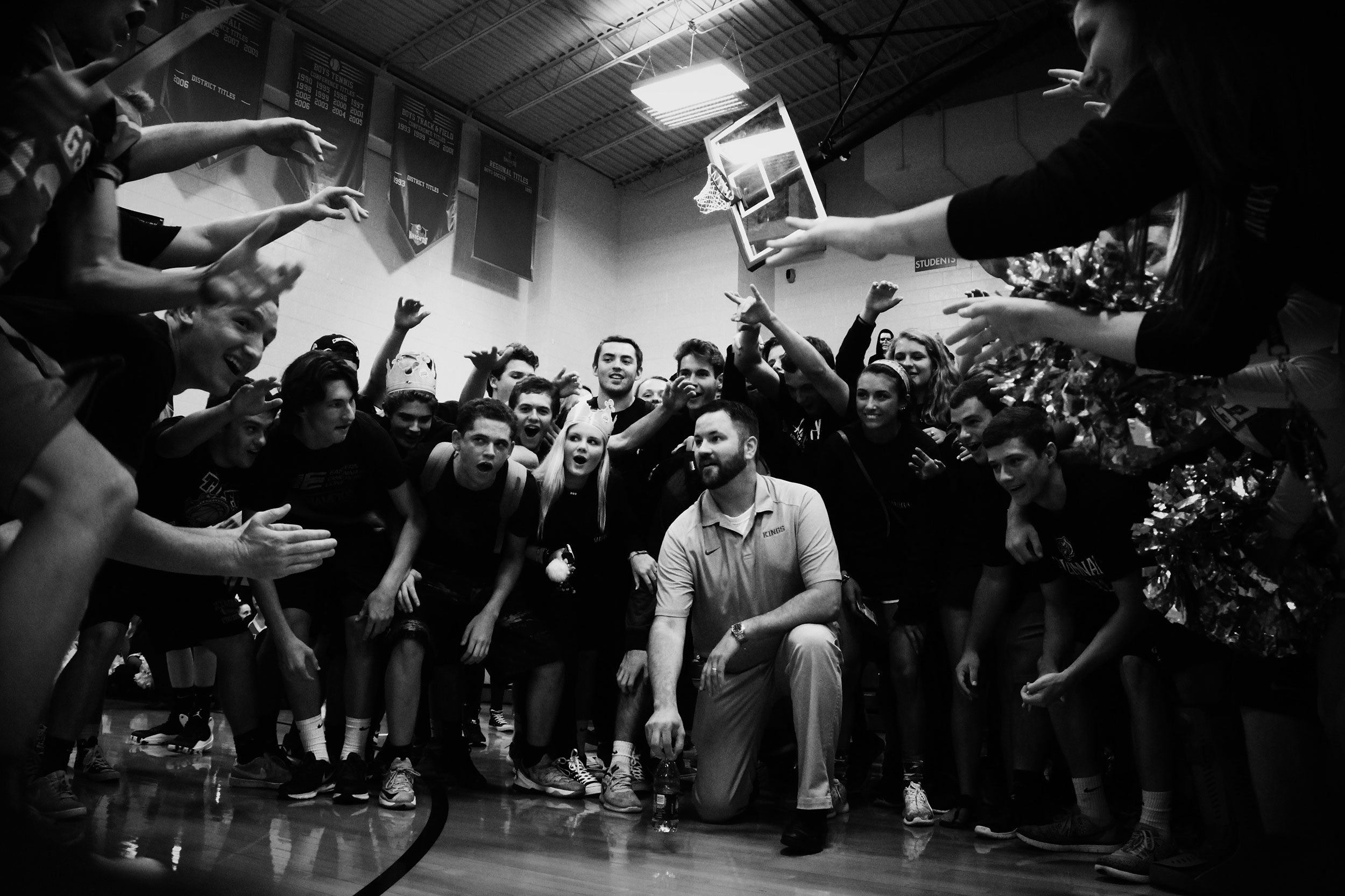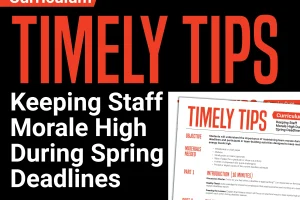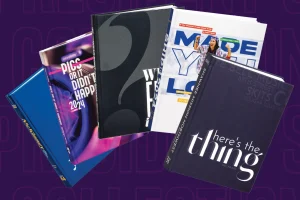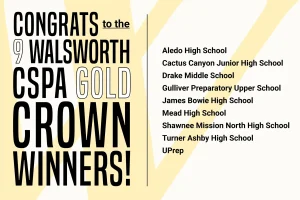
15 Ways to Ramp Up Your Yearbook Recruiting Effort Right Now
(Updated by Walsworth Yearbooks)
Written by Sarah Champ
We know yearbook recruiting occurs year round, but with class selection and enrollment around the corner, right now is the most important time of year to focus on developing next year’s program.
Check out the Walsworth Yearbooks training video It’s Time to Start Recruiting and download our Recruiting Yearbook Staffs: Methods to the Madness eBook. These will help you develop an effective, organized recruiting effort for your yearbook program.
Every adviser’s circumstance differ, but when it comes to building a staff, much of the process is the same. You have the same goals (a successful team of students who produce a great book) and face the same challenges (increased graduation requirements, competing activities and AP courses, well-rounded representation, etc.). Whether you’re a new adviser or a seasoned veteran, high school or middle school yearbook, a class or a club, here are 15 things you can do throughout the next few weeks to ramp up your recruiting efforts — adopt and adapt as necessary:
1. Assess your goals, needs and structure
You won’t know exactly what you’re looking for until you determine what you need. Depending on the objectives of your book and program, you may divide staff responsibilities by section of the yearbook or by job roles themselves — or maybe a bit of both. So first, identify strengths and areas that need improvement, and set goals; from there, you can better tailor your recruitment efforts to your needs.
2. Create recruiting materials and put up fliers around school
Use posters, flyers, stickers, locker notes and social media graphics around school. This shouldn’t be the only tool in your arsenal, but it should definitely be one of them. Students and staff see this stuff, and it can draw people to your classroom or to a meeting. Also, create an informational handout to leave behind at meetings, classroom visits, open houses, etc. Remember, these items are a representation of your program, so make sure they’re designed well and stand out. You can create your own or use Walsworth’s recruiting materials.
3. Create a promo video
Have students create a recruitment video. Air it on your school’s daily announcements, post it on your website and via social media, and have staff members share it on their accounts as well. Use this as an opportunity to market both your program for recruitment purposes as well as the yearbook itself to drive sales.
4. Put information in school announcements
Reinforcement if nothing else. On top of fliers, personal conversations, videos, classroom visits, etc., getting some air time with students and/or a message sent home to parents only keeps your program top of mind and gives an opportunity to reiterate course offerings, application deadlines, meeting times, etc.
5. Speak to guidance counselors about your program
Getting the administration and counselors in your corner is the best place to start. Share with them your goals, examples of how you’re creating a journalistic program and what students learn and gain from the experience. If you make a case for your curriculum, as well as the type of kids who succeed in it, when registration time comes, counselors will know who to funnel towards your classes.
6. Ask other teachers for referrals
Check with photography, art, business and tech teachers for students who enjoy taking pictures, understand color and design, are creative marketers or do well creating on the computer. And then, of course, ask language arts and AP instructors to recommend students who excel in writing, editing and storytelling.
7. Have a presence at curriculum night or electives fair
Before students register for classes, most schools host a sort of back-to-school open house or curriculum night, a great opportunity for students and parents to get acquainted with academic and extracurricular offerings. Attend this event at your school and, if possible, at feeder schools. Be among the teachers and club sponsors showcasing their programs, and display the work you and your students do.
8. Target underrepresented demographics
Your program serves the school, so your yearbook staff should reflect the makeup of the student population.
Find out the percentages of students by gender, ethnicity and economic status. Also, seek students who represent a cross section of grade levels, sports, clubs and other organizations. Then, employ the help of other teachers, coaches, guidance counselors and current staff members to figure out who, among that group, could be a good fit for yearbook.
9. Use student media to promote the program
School website, newspapers, social media, televised announcements, etc. — leave no stone unturned in the days leading up to an informational meeting or the application deadline. These platforms tend to have a large student following, so it’s an easy and effective way to get your message out.
10. Host an open informational meeting
Hold an after-school meeting to introduce and explain the yearbook process to prospective students. Promote it in advance and also have current staffers bring at least two people they know. Share examples of student work and, if relevant, your course offerings. Enlist a handful of staffers to help host and do a question-answer session.
11. Classroom presentations
The same teachers and courses you would tap for referrals will also be the best places to go to speak directly to prospective students. Include a couple of well-spoken current editors and staffers, and come up with a brief and compelling agenda. Present a video, engage students in an activity or Q&A, share informational handouts and examples of your work, tell anecdotes, etc. Think specifically about the course and type of students you’re speaking to with each presentation and tailor your message accordingly. If it’s business/tech, highlight that aspect of the program; for photo or art, do the same. Be succinct and respectful — leave the students wanting more and the teachers wanting to support your cause.
12. Visit feeder schools
This should be an ongoing effort, from regularly delivering fliers and newspapers, getting in the student announcements, building relationships with administration and teachers, etc. However, in the short-term, a well-planned visit to incoming students at feeder school(s) can make a big impact for your program. Try to get in and present to relevant classes (language arts, design, art, business, etc.), host a workshop or see if you can schedule something for after school. Regardless of how students funnel into yearbook (intro course, open to anybody, upper classmen only, etc.), these visits create early exposure and more visibility, and can help establish a relationship with other teachers/advisers.
13. Leverage your current staff
Brainstorm with them and get them to help spread the word. Have your staff members each recommend at least three potential new staffers — think of students who seem creative, engaged and what difference they could bring to the program — and have your staff then personally invite them to an informational meeting or invite them to apply. Also, talk with your staff about promoting the program and journalism classes in conversation and on social media during the registration period. Students listen to other students, so the personal invitations and peer endorsements go a long way.
14. Letters of invitation
You have the referrals from your colleagues and staff. Now, reach out to these individuals personally, inviting them to consider journalism/yearbook if they think it meets their interests and needs. Explain what the program has to offer and maybe even share who recommended them and why. This could help top prospects better see how they fit into the big picture and motivate them to more seriously consider the opportunity.
15. Have an application process
This can be as simple as filling out a simple form and submitting it on time or as extensive as requiring letters of recommendation, a cover letter, etc. Bottom line, any application process will help weed out students who won’t take the commitment seriously. Anyone who can’t take the time and care to formally apply or to do so by a set deadline is probably not someone you want in your program. On the other end of the spectrum, the process creates a level of excitement and pride among students who then get selected to be on staff. Check out Walsworth’s staff application that’s ready to customize or is a great reference for creating your own.



